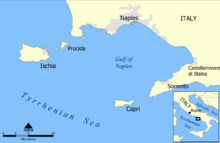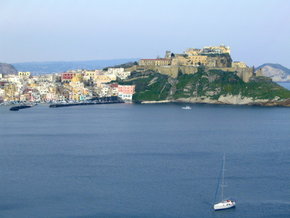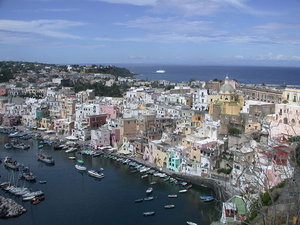Procida
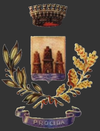
| |
| Comune di Procida | |
|---|---|
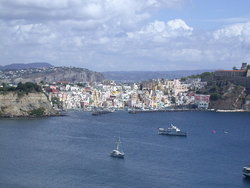
| |
| Region | Campania |
| Province | Naples (NA) |
| Name | Procida |
| Mapx | 40.88 |
| Mapy | 14.1 |
| Elevation m | 15 |
| Area total km2 | 4.1 |
| Population as of | December 31, 2004 |
| Population total | 10694 |
| Population density km2 | 2594 |
| Timezone | CET, UTC+1 |
| Frazioni | Vivara |
| Telephone | 081 |
| Postalcode | 80079 |
| Gentilic | Procidani |
| Saint | St. Michael |
| Day | September 29 |
| Mayor | Gerardo Lubrano Lavadera |
| Website | www.comune.procida.na.it |
Procida is one of the Phlegrean islands off the coast of Naples in southern Italy. The island is between Cape Miseno and the island of Ischia. With its tiny satellite island of Vivara, it is a comune of the province of Naples, in the region of Campania. The population is c. 10,000.
Etymology of the name
The island derives its name from the Latin name Prochyta. According to another theory, the name comes from Prima Cyme, meaning 'near Cuma'. Yet another theory says that 'Procida' comes from the Greek verb prokeitai, meaning 'it lies forth', because of the appearance of the island seen from the sea.
Geography
Procida is located between Capo Miseno and the island of Ischia. It is less than 4km2. Its coastlines, very jagged, are 16 km (10 miles). The Terra Murata hill is the highest point on the island (91m).
Creation of the island
Geologically, Procida was created by the eruption of four volcanoes, now dormant and submerged.
History
Ancient history
Procida was held by Mycene in the period between the 16th and 15th centuries BC. During the 8th century BC the first Greek settlers to this island were immediately replaced by other Greek peoples coming from Cuma.
During Roman rule, Procida became a renowned resort for the patrician class of Rome.
Middle Ages
After the fall of the Western Roman Empire and the Byzantine reconquest in the Gothic Wars (6th century)), Procida remained under the jurisdiction of the Duke of Naples. The continual devastation first by the Vandals and Goths, and later by the Saracens, pushed the population to resettle in a fortified village typical of Medieval times. The population was sheltered by a cape, naturally defended by walls that peak on the sea that were later fortified, thus acquiring the name of Terra Murata, (Walled earthwork).
Testimonies from this period are from those who manned the watchtowers on the sea, which became the symbol of the island. With the Norman conquest of Southern Italy, Procida experienced feudal dominion; the island, with a mainland annex (the future Mount of Procida), came under the control of the Da Procida family which continued to hold the island for more than two centuries. The most famous member of the family was John III of Procida, counsellor to Emperor Frederick II and leader of the revolt of the Sicilian Vespers.
In the 1339, the fiefdom, together with the Island of Ischia, was handed over to the Cossa family, of French origin, loyal followers of the Angevin dynasty then reigning in Naples. Baldassare Cossa was elected Antipope in 1410 with the name of John XXIII. In this period a deep economic transformation of the island began, as agriculture was slowly abandoned in favour of fishing.
Modern era
During the rule of Charles V the island was granted to the D'Avalos family. Pirate raids continued during this period. Particularly notable was one in 1534, led by the infamous Turk admiral Khair ad Din, better known as Barbarossa.
In 1744 King Charles III made Procida a royal game reserve. In this period the Procidan fleet reached its zenith, backed by a period of flourishing shipbuilding. The population rose to approximately 16,000. In 1799, Procida took part in the revolts that led to the proclamation of the Neapolitan Republic. With the return of the Bourbon dynasty a few months later 12 Procidans were beheaded.
The Napoleonic Wars brought several episodes of devastation due to the island's strategic position in the naval engagements between French and English. In 1860, after the fall of the Kingdom of the Two Sicilies, the island became part of the newly formed Kingdom of Italy.
The 20th century
The 20th century saw a crisis in Procidan shipbuilding due to competition with industrial conglomerates. In 1907 Procida lost its mainland territory, which became independent and is commonly called the Mount of Procida (Monte di Procida).
In 1957, the first underwater aqueduct in Europe was built in Procida.
In the last few decades, the population has slowly begun to grow. The economy remains in great part tied to the marine industry, although the tourist industry has also grown.
Novels and movies about Procida
Several writers have set their novels in Procida. One of the most notable is the novel Graziella written by Alphonse de Lamartine, who came to Procida at the beginning of the 19th century while in the French army. Another celebrated novel is L'isola di Arturo (1957), one of the greater works of Elsa Morante.
Procida has been chosen as a film set for numerous films, mainly for its panoramas and its typical Mediterranean architecture. The most famous are Il Postino and The Talented Mr. Ripley.
Folklore and traditions
There are many religious traditions on the island tied to the period of Holy Week before Good Friday. The most evocative of these are the Procession of the Apostles of Holy Thursday and the Procession of the Mysteries of Good Friday. The last one is based on a tradition going back to the end of the 17th century. In the procession, the young males of the island, dressed in the traditional dress of the "Confraternity of the Turchini", carry allegorical wagons (called "mysteries") of religious character for a fixed distance, from the village of Torre Murata to the port of Marina Grande. The "mysteries", often highly artistic, are prepared by the young people and generally nobody except them would have, at least in theory, seen them before the procession. After the procession, they are taken apart or destroyed.
Every summer, there is an election of the Graziella ("Little Graceful"), a young woman that wears the customary clothes of the island, referring to the history told in Alphonse de Lamartine's novel, Graziella. Also during the summer, a literary award dedicated to Elsa Morante and her novel, Arthur's Island, is presented.
External links
